The history of prepaid postage
Hi% username!
I hope you will be pleasantly surprised by our excursion into the postal technology. There are not so many developments, but they are all extremely complex and incredibly interesting. Be sure to go through the present, but first, a tribute to history and memory. Otherwise it is difficult to understand the scale.
The first documented use of a prototype courier service for distributing written documents was recorded in Egypt, where pharaohs used couriers to announce their decrees on papyrus sheets around 2400 BC. The next best studied example is a runner in ancient Greece, who in 490 BC delivered a message from the Marathon to Athens (42.195 km) about the victory of the Greek army over the king of Persia.
The ancient Romans owned a well-organized network of couriers to spread messages for the army. They created special stations where they could spend the night or change a horse. The Latin names of the stations for the change (mutatio posita) and rest (mansio posita) became the progenitor of the word “Post”.
')
In the 12th and 14th centuries, knightly orders built a professional mail delivery system for their own needs. For centuries, messages were delivered by couriers or traveling salesmen on foot or by horse, and then by mail carriages. In 1490, Italian Zhanetto von Tassis (Janetto von Tassis, hereinafter referred to as Thurn und Taxis) received an exclusive license from the Habsburg emperor Maximilian I to organize a postal transport service for army and administrative communications through the Habsburg territory. He organized horse replacement stations and staffed couriers with furnaces for guaranteed and reliable delivery at a distance of 1024 km between Innsbruck (Innsbruck, Austria) and Mechelen (Belgium) for 5 or 6 days, regardless of summer or winter time. Later Zhanetto operated a postal network across the entire eastern continental Europe, and again received an exclusive license from the Emperor of Habsburg, Rudolph II, to provide postal transport services for the government. To reduce costs, Janetto was allowed to transport messages between private individuals. This license was the basis for the creation of the first postal system on continental Europe.

Until the 17th century, it was normal practice for addressees to go on a trip to the post office to collect correspondence. The process turned out to be extremely unpleasant, if the alleged correspondence did not reach this point. Around the year 1700, the Post of Prussia introduced a system of mail delivery by private servants for privileged recipients. The first official service for the delivery of letters was mentioned in the statutes of the Post of Prussia in 1710. The official street mailbox, presented by Prussia Post in 1824, was also a huge relief for senders.
Until 1850, it was natural to charge only from the recipients of the consignment and only after successful delivery. Addressees often refused to pay items, moving them to the category of unclaimed. This gave a lot of inconvenience, because the fact of delivery has already taken place. Moreover, the price for departure usually depended on the chosen delivery route. Since accurate maps were not available to everyone, the price for delivery for the recipient always turned out to be different.
Due to the fact that the price of delivery in most cases was high and was equal to the average cost of a working day, people were looking in every possible way for all kinds of ways to reduce prices. For example, there were senders and addressees using special symbols applied to the departure shell, from which it was possible to understand about the contents without any further opening. The recipient has always refused to receive such a shipment, leaving the choice behind the courier - to destroy the shipment or go back and take the cost of shipment from the sender. The risk of non-payment by the recipient has led the industry to uncertainty that hinders the development of postal delivery standards.
The first centralized postal service within the country was established in England in 1516. In the document “Postal Reform: Its Significance and Expediency” written by Sir Rowland Hill in 1835, a proposal was made to charge all letters up to 14.5 grams with a one-penny fee, with obligatory payment by the sender in the form of a stamp sticker. Due to this, the problem of refusals from shipments should have been solved.
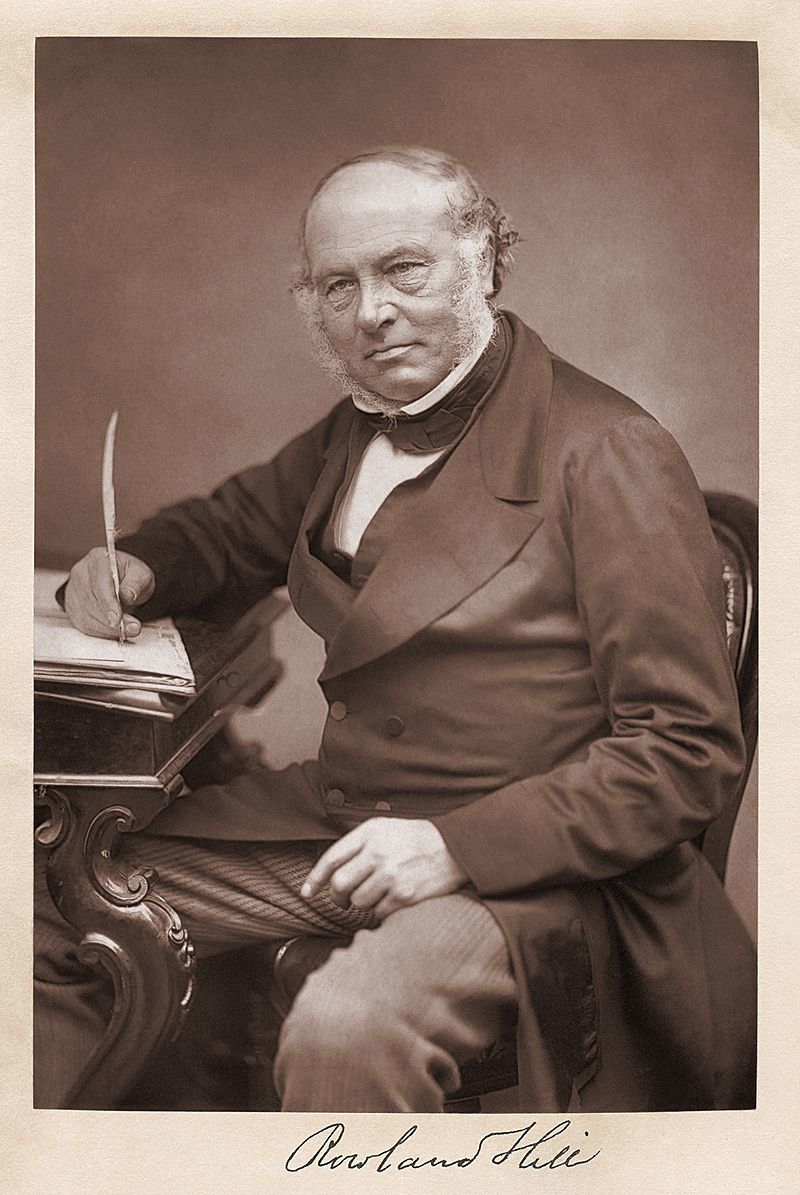
The required level of senders' confidence in the plans must be maintained through the creation of an official postal system and the unification of postal tariffs. It was also predicted a reduction in tariffs against the background of a huge increase in the volume of items and, as a result, an increase in income for the postal system and the Queen of England itself. The plan was passed, and the bill was signed by Queen Victoria on the 17th of August, 1839.
The first stamp was issued in 1840 in England. They were One Penny Black and Two Pens Blue . The portrait of Queen Victoria was taken from a medal made by William Wyon. The prepaid envelope is designed by William Molredi.
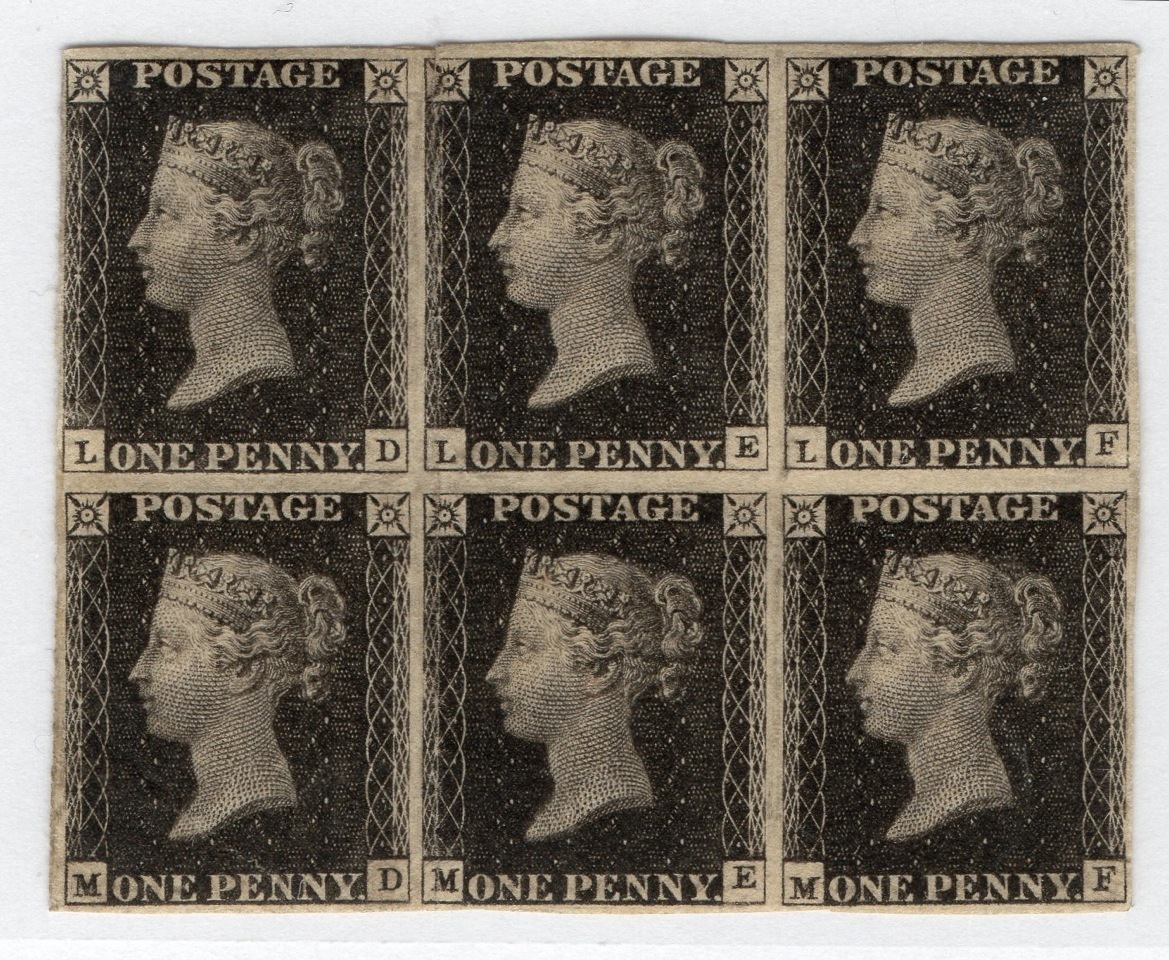
The first brand on the planet Earth
Reform of the postal system, started by Sir Rowland Hill (sir Rowland Hill) was really successful - in one year the volume of shipments in the UK tripled . The main reason was the simplest pricing. A huge number of postal operators in continental Europe and America have adapted the concept of prepaid items in the form of stamps with a self-adhesive base. The USA issued the first stamp in 1847, Germany in 1872, Japan, - 1871.
In order to standardize postal rules and actions at the international level, the United States called for the creation of an international postal congress, first convened in 1863. The union was chaired by Heinrich von Stephan, Prussian minister of mail. In the future, it was he who headed and founded the Universal Postal Union.
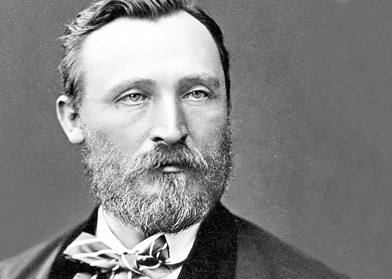
Founder of the Universal Postal Union, Heinrich von Stefan
The Main Postal Union, that is exactly the result of the agreement in Burne signed on October 9, 1874, was the community, which included 22 countries. Already at the second world postal meeting in Paris in 1878, the name was changed to “Universal Postal Union” . At this congress, the UPU decided that all postal letters, postcards and parcels should come with a payment symbol in the form of a stamp.
The Union also decided on the introduction of a universal single tariff for sending letters worldwide; on providing the same conditions for domestic and foreign shipments; on the preservation of all funds collected for international shipments. These fundamental rules allowed the senders to be relieved of a huge headache - they didn’t need to calculate more in which way and through which countries the departure would go in order to properly apply stamps. The UPU decided that the stamps issued by the member countries were adapted for the entire route of departure, subject to the presence of letters of the Latin alphabet.
Inspired by the success of the development of stamps in many countries, the UPU at the Second World Postal Congress in 1878 in Paris decided to use stamps and only stamps as evidence of payment. But the decision caused a great resonance and seemed short-sighted, since the use of stamps was a very inefficient tool for large senders.
It took postal operators several years to create a replacement technology. In 1889, Josef Baumann demonstrated the first imprint device, similar to the mark , to the Bavarian postal representative (Bavarian postal authorities), which rejected his proposal. Later, he improved the algorithm of the machine and even received a patent on January 5, 1900, but not a single technology received mail approval.
The first franking machine, which stamped on a paper envelope, indicating the mark of customer payment for postal services , was developed by Karl Uchemann and produced by the Norwegian company Krag in 1903.
Each of the machines allowed the imprint to be fixed with a fixed equivalent in the 5 Danish Eras and received consent to be used by the Norwegian post office on June 15, 1903. Four franking machines were used in post offices, three in private companies. However, in the near future they began to withdraw, - the latter was seized already January 2, 1905.
Since 1902, Arthur Pitney (Arthur H. Pitney) has designed a series of mechanical franking machines without receiving any approval from US Post. Only after combining efforts with Walter Bowes (Walter H. Bowes), did they successfully present in 1920 the franking machine for first class M shipments with the possibility of adjusting the imprint date.
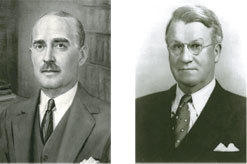
Founders of Pitney Bowes, Arthur Pitney and Walter Bowes
In the same year, at the 7th congress in Madrid, Spain, the UPU officially recognized the imprint of the franking machine as signifying payment and decides to apply it only with red paint.

Ford Model T. Oh, sorry, Pitney Bowes Model M.
While Pitney Bowes Model M was able to apply only one impression of a print, in 1923 in Germany, Bafra and Anker Werkle formed Francotyp, which received approval for the first franking machines with adjustable print amounts. This was particularly necessary during hyperinflation in Germany after the First World War.
Unlike stamps, the impression of a franking machine contains the date of shipment and is applied irreversibly on the shipment. The stamps were usually reused, it was enough to carefully detach them and put them on the glue again. To reduce the loss of revenue from the reuse of stamps, postal administrations have introduced a cancellation procedure, in which a use indicator is applied to a stamp. The prints of the franking machines did not require blanking - they contained the date of shipment and could not be easily copied from one shipment to another. The maximum required from the postal officer was to verify the current date and the date stamped on the franc.
A huge number of changes occurred over the next decade. Mechanical counters began to store mail registers, i.e. the remaining amount available to be written off in francs. To “recharge” the car was taken to the post office for opening and unlocking. This was the main protection against unauthorized use, because Attempts to self-autopsy necessarily leave material evidence.
Against the background of economic growth, the volume of items grew, and postal operators had to increase the level of automation to service it. So Germany was the first where the postal code system was introduced to increase the speed of sorting and the quality of delivery of shipments in 1960. In 1963, US Post showed the system of ZIP codes ( ZIP code , Zone Improvement Plan, Zonality Improvement Plan), which later became the basis of US indices .
In the 1970s, electromechanical franking machines appeared on the market, including a microprocessor and the ability to store mail registers already in a random access memory device (RAM, Random Access Memory). The printing system also developed and made it possible to process up to 12,000 shipments per hour. Users "refueled" their cars using a regular phone. After the caller and his device were identified, the user reported the amount and entered the code received from the operator. The franking machine checked the entered code and unlocked the amount offline. This allowed to get rid of annoying trips to the post office.
The boom of personal computers and office printers has revolutionized. In the late 1980s, with the help of modems already built into franking machines, the amount to download was downloaded via the telephone network and a secure channel from a remote server directly. This turned out to be much safer than the oral transfer of codes for replenishment.
The next generation of franking machines was electronic. These machines used digital printing technology instead of the traditional use of mechanical dies. In 1991, Francotyp-Postalia first introduced the T1000 digital franking machine equipped with thermal printing technology (thermal transfer print system).
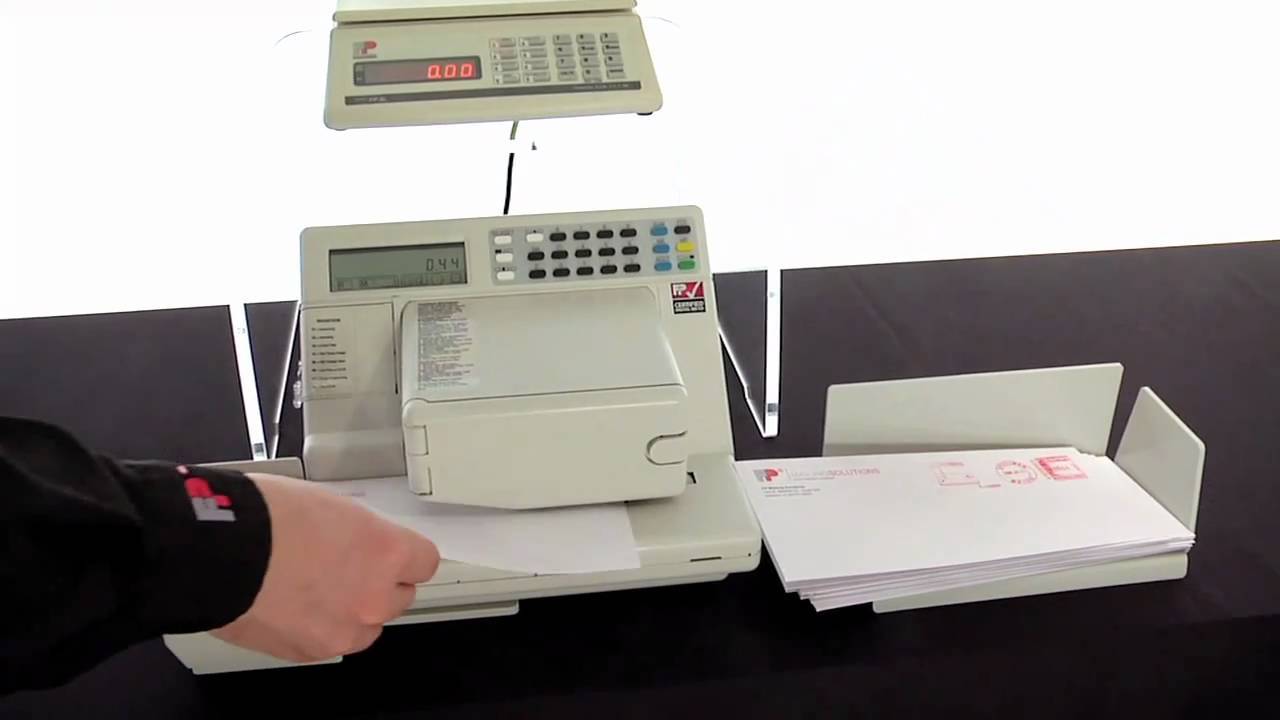
T1000, the first electronic franking machine.
The technology of digital printing made it possible to control the contents of each impression of the franking machine and apply it at high speed. When the technology of jet coating began to spread in the 90s, it also found use in franking equipment.
While the market was trying to replace expensive, highly specialized devices with personal computers, the postal administrations seriously worried about the increasing number of fakes and manipulation of prints. Forging the fact of payment of the shipment with the scanner and the printer again became extremely simple, therefore many postal operators have obliged to use fluorescent paint for printing.

I hope you will be pleasantly surprised by our excursion into the postal technology. There are not so many developments, but they are all extremely complex and incredibly interesting. Be sure to go through the present, but first, a tribute to history and memory. Otherwise it is difficult to understand the scale.
The origin of the word "Mail" and its mandatory attributes
The first documented use of a prototype courier service for distributing written documents was recorded in Egypt, where pharaohs used couriers to announce their decrees on papyrus sheets around 2400 BC. The next best studied example is a runner in ancient Greece, who in 490 BC delivered a message from the Marathon to Athens (42.195 km) about the victory of the Greek army over the king of Persia.
The ancient Romans owned a well-organized network of couriers to spread messages for the army. They created special stations where they could spend the night or change a horse. The Latin names of the stations for the change (mutatio posita) and rest (mansio posita) became the progenitor of the word “Post”.
')
In the 12th and 14th centuries, knightly orders built a professional mail delivery system for their own needs. For centuries, messages were delivered by couriers or traveling salesmen on foot or by horse, and then by mail carriages. In 1490, Italian Zhanetto von Tassis (Janetto von Tassis, hereinafter referred to as Thurn und Taxis) received an exclusive license from the Habsburg emperor Maximilian I to organize a postal transport service for army and administrative communications through the Habsburg territory. He organized horse replacement stations and staffed couriers with furnaces for guaranteed and reliable delivery at a distance of 1024 km between Innsbruck (Innsbruck, Austria) and Mechelen (Belgium) for 5 or 6 days, regardless of summer or winter time. Later Zhanetto operated a postal network across the entire eastern continental Europe, and again received an exclusive license from the Emperor of Habsburg, Rudolph II, to provide postal transport services for the government. To reduce costs, Janetto was allowed to transport messages between private individuals. This license was the basis for the creation of the first postal system on continental Europe.

The horn is still found in postal logos.
Payment for postal services in advance? No, not heard!
Until the 17th century, it was normal practice for addressees to go on a trip to the post office to collect correspondence. The process turned out to be extremely unpleasant, if the alleged correspondence did not reach this point. Around the year 1700, the Post of Prussia introduced a system of mail delivery by private servants for privileged recipients. The first official service for the delivery of letters was mentioned in the statutes of the Post of Prussia in 1710. The official street mailbox, presented by Prussia Post in 1824, was also a huge relief for senders.
Until 1850, it was natural to charge only from the recipients of the consignment and only after successful delivery. Addressees often refused to pay items, moving them to the category of unclaimed. This gave a lot of inconvenience, because the fact of delivery has already taken place. Moreover, the price for departure usually depended on the chosen delivery route. Since accurate maps were not available to everyone, the price for delivery for the recipient always turned out to be different.
Due to the fact that the price of delivery in most cases was high and was equal to the average cost of a working day, people were looking in every possible way for all kinds of ways to reduce prices. For example, there were senders and addressees using special symbols applied to the departure shell, from which it was possible to understand about the contents without any further opening. The recipient has always refused to receive such a shipment, leaving the choice behind the courier - to destroy the shipment or go back and take the cost of shipment from the sender. The risk of non-payment by the recipient has led the industry to uncertainty that hinders the development of postal delivery standards.
The first centralized postal service within the country was established in England in 1516. In the document “Postal Reform: Its Significance and Expediency” written by Sir Rowland Hill in 1835, a proposal was made to charge all letters up to 14.5 grams with a one-penny fee, with obligatory payment by the sender in the form of a stamp sticker. Due to this, the problem of refusals from shipments should have been solved.

Sir Rowland Hill
The first attempt to introduce prepaid items
The required level of senders' confidence in the plans must be maintained through the creation of an official postal system and the unification of postal tariffs. It was also predicted a reduction in tariffs against the background of a huge increase in the volume of items and, as a result, an increase in income for the postal system and the Queen of England itself. The plan was passed, and the bill was signed by Queen Victoria on the 17th of August, 1839.
The first stamp was issued in 1840 in England. They were One Penny Black and Two Pens Blue . The portrait of Queen Victoria was taken from a medal made by William Wyon. The prepaid envelope is designed by William Molredi.

The first brand on the planet Earth
Reform of the postal system, started by Sir Rowland Hill (sir Rowland Hill) was really successful - in one year the volume of shipments in the UK tripled . The main reason was the simplest pricing. A huge number of postal operators in continental Europe and America have adapted the concept of prepaid items in the form of stamps with a self-adhesive base. The USA issued the first stamp in 1847, Germany in 1872, Japan, - 1871.
In order to standardize postal rules and actions at the international level, the United States called for the creation of an international postal congress, first convened in 1863. The union was chaired by Heinrich von Stephan, Prussian minister of mail. In the future, it was he who headed and founded the Universal Postal Union.

Founder of the Universal Postal Union, Heinrich von Stefan
Postal interaction at the international level
The Main Postal Union, that is exactly the result of the agreement in Burne signed on October 9, 1874, was the community, which included 22 countries. Already at the second world postal meeting in Paris in 1878, the name was changed to “Universal Postal Union” . At this congress, the UPU decided that all postal letters, postcards and parcels should come with a payment symbol in the form of a stamp.
The Union also decided on the introduction of a universal single tariff for sending letters worldwide; on providing the same conditions for domestic and foreign shipments; on the preservation of all funds collected for international shipments. These fundamental rules allowed the senders to be relieved of a huge headache - they didn’t need to calculate more in which way and through which countries the departure would go in order to properly apply stamps. The UPU decided that the stamps issued by the member countries were adapted for the entire route of departure, subject to the presence of letters of the Latin alphabet.
Inspired by the success of the development of stamps in many countries, the UPU at the Second World Postal Congress in 1878 in Paris decided to use stamps and only stamps as evidence of payment. But the decision caused a great resonance and seemed short-sighted, since the use of stamps was a very inefficient tool for large senders.
It took postal operators several years to create a replacement technology. In 1889, Josef Baumann demonstrated the first imprint device, similar to the mark , to the Bavarian postal representative (Bavarian postal authorities), which rejected his proposal. Later, he improved the algorithm of the machine and even received a patent on January 5, 1900, but not a single technology received mail approval.
The first franking machine, which stamped on a paper envelope, indicating the mark of customer payment for postal services , was developed by Karl Uchemann and produced by the Norwegian company Krag in 1903.
Each of the machines allowed the imprint to be fixed with a fixed equivalent in the 5 Danish Eras and received consent to be used by the Norwegian post office on June 15, 1903. Four franking machines were used in post offices, three in private companies. However, in the near future they began to withdraw, - the latter was seized already January 2, 1905.
Mechanization of the postal industry
Since 1902, Arthur Pitney (Arthur H. Pitney) has designed a series of mechanical franking machines without receiving any approval from US Post. Only after combining efforts with Walter Bowes (Walter H. Bowes), did they successfully present in 1920 the franking machine for first class M shipments with the possibility of adjusting the imprint date.

Founders of Pitney Bowes, Arthur Pitney and Walter Bowes
In the same year, at the 7th congress in Madrid, Spain, the UPU officially recognized the imprint of the franking machine as signifying payment and decides to apply it only with red paint.

Ford Model T. Oh, sorry, Pitney Bowes Model M.
While Pitney Bowes Model M was able to apply only one impression of a print, in 1923 in Germany, Bafra and Anker Werkle formed Francotyp, which received approval for the first franking machines with adjustable print amounts. This was particularly necessary during hyperinflation in Germany after the First World War.
Unlike stamps, the impression of a franking machine contains the date of shipment and is applied irreversibly on the shipment. The stamps were usually reused, it was enough to carefully detach them and put them on the glue again. To reduce the loss of revenue from the reuse of stamps, postal administrations have introduced a cancellation procedure, in which a use indicator is applied to a stamp. The prints of the franking machines did not require blanking - they contained the date of shipment and could not be easily copied from one shipment to another. The maximum required from the postal officer was to verify the current date and the date stamped on the franc.
The rapid development and standardization of the industry
A huge number of changes occurred over the next decade. Mechanical counters began to store mail registers, i.e. the remaining amount available to be written off in francs. To “recharge” the car was taken to the post office for opening and unlocking. This was the main protection against unauthorized use, because Attempts to self-autopsy necessarily leave material evidence.
It has become common practice to use four postal registers in franking machines.
- AR, Ascending Register , increasing register. A register that increases each time an impression is created by the amount indicated in the receipt.
- DR, Descending Register , decreasing register. The register increases with each recharge by the amount of recharge, and decreases each time an impression is created by the amount specified in the print.
- TS, Total Settings Register , general settings register. The register increases with each recharge by the amount of recharge. At any time, the register shows the amount between AR and DR.
- PC, Piece Count Register , register counting pieces. The register is incremented every time an image is produced. The register stores the total number of all prints since initialization.
Against the background of economic growth, the volume of items grew, and postal operators had to increase the level of automation to service it. So Germany was the first where the postal code system was introduced to increase the speed of sorting and the quality of delivery of shipments in 1960. In 1963, US Post showed the system of ZIP codes ( ZIP code , Zone Improvement Plan, Zonality Improvement Plan), which later became the basis of US indices .
In the 1970s, electromechanical franking machines appeared on the market, including a microprocessor and the ability to store mail registers already in a random access memory device (RAM, Random Access Memory). The printing system also developed and made it possible to process up to 12,000 shipments per hour. Users "refueled" their cars using a regular phone. After the caller and his device were identified, the user reported the amount and entered the code received from the operator. The franking machine checked the entered code and unlocked the amount offline. This allowed to get rid of annoying trips to the post office.
The Internet is changing the rules of the game
The boom of personal computers and office printers has revolutionized. In the late 1980s, with the help of modems already built into franking machines, the amount to download was downloaded via the telephone network and a secure channel from a remote server directly. This turned out to be much safer than the oral transfer of codes for replenishment.
The next generation of franking machines was electronic. These machines used digital printing technology instead of the traditional use of mechanical dies. In 1991, Francotyp-Postalia first introduced the T1000 digital franking machine equipped with thermal printing technology (thermal transfer print system).

T1000, the first electronic franking machine.
The technology of digital printing made it possible to control the contents of each impression of the franking machine and apply it at high speed. When the technology of jet coating began to spread in the 90s, it also found use in franking equipment.
While the market was trying to replace expensive, highly specialized devices with personal computers, the postal administrations seriously worried about the increasing number of fakes and manipulation of prints. Forging the fact of payment of the shipment with the scanner and the printer again became extremely simple, therefore many postal operators have obliged to use fluorescent paint for printing.

Source: https://habr.com/ru/post/297780/
All Articles